A Global Review for Tourism report was released today. It looked at the measures of 217 destinations worldwide The research shows that 7 destinations have eased travel restrictions for international tourism purposes. At the same time, several more destinations are engaged in significant discussions about the re-opening of borders.
رپورٽ ۾ نوٽ ڪيو ويو آهي 100% of all destinations worldwide continue to have some form of COVID-19-related travel restrictions in place. Furthermore, as of 18 May 2020, 75% continued to have their borders completely closed for international tourism. In 37% of all cases, travel restrictions have been in place for 10 weeks, while 24% of global destinations have had restrictions in place for 14 weeks or more.
From a regional point of view, the destinations that have completely closed their border represent: o 74% of destinations in Africa o 86% of destinations in the Americas o 67% of destinations in Asia and the Pacific o 74% of destinations in Europe o 69% of destinations in the Middle East
The following categories of COVID-19 related travel restrictions are being applied across destinations worldwide (total destinations are 217): o Complete or partial closure of borders: 185 destinations (85%) have completely or partially closed their borders (increase from 166 destinations on 27 April 2020).
Out of these, 163 destinations have completely closed their borders (increase from 156 destinations) for international tourists including air, sea, and land borders. Some exemptions are usually made for nationals, residents, commuters, diplomats, and for essential travel purposes.
Out of these, 163 destinations have completely closed their borders (increase from 156 destinations) for international tourists including air, sea, and land borders. Some exemptions are usually made for nationals, residents, commuters, diplomats, and for essential travel purposes.
Suspension of flights: 11 destinations (5%) have suspended completely or partially international flights (decrease from 26 destinations).
Destination-specific travel restriction: 10 destinations (5%) are implementing the closing of borders in a more differentiated manner by banning the entry for passengers from specific countries of origin (an increase from 9 destinations)
Different measures: The remaining 12 destinations (5%) are applying different measures, such as quarantine or self-isolation for 14 days, visa measures, or requesting medical screenings and/or medical certificate before or after arrival (decrease from 16 destinations).
As of 18 May 2020, a total of 7 destinations10 (3% of all destinations worldwide) have eased travel restrictions for international tourism purposes. Nevertheless, all destinations worldwide (100%) continue to have COVID-19 related travel restrictions in place.
Travel restrictions including the complete or partial closure of borders, destination-specific travel restrictions, suspension of flights, and other measures have been in place for ten weeks in 37% of destinations worldwide (80 destinations) and during the past 14 weeks in 24% of destinations worldwide (51 destinations). In fact, most destinations worldwide (75%) continue to have their borders completely closed to international tourists (163 destinations out of 217 in total).
During the last fortnight, the gradual lifting of national lockdown and quarantine measures has started in some countries bringing some first promising signs for international tourism to recover. Yet, travel advisories, limited flight connections, health concerns as well as potential travel restrictions upon return are still making international travel for tourism purposes very challenging.
The impact of travel restrictions on international tourism due to COVID-19 is reflected in the available data on international arrivals for the first quarter of 2020 which shows a decrease of 22%, while international arrivals in the month of March have been down by 57%. The latest scenarios point at possible declines in international arrivals for 2020 to range from 58% to 78% over 2019 data. These scenarios depend on the speed of containment of the virus, the duration of travel restrictions and the shutdown of borders and the confidence of the international traveler to resume travel
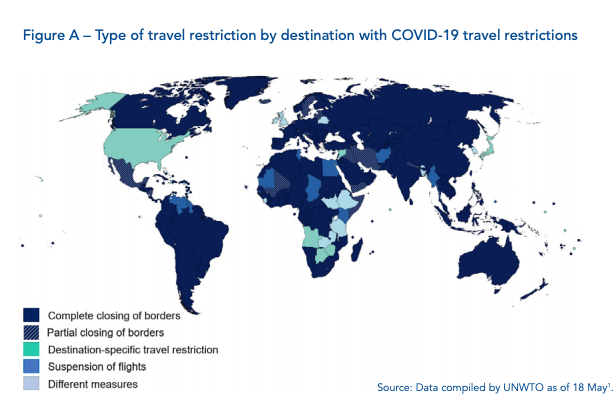
The opening of borders for international tourists is of particular relevance for the recovery of the tourism sector in all destinations and even more for those with a high dependence on international tourism. In view of the upcoming holiday season in the Northern Hemisphere, tourism is becoming an increasingly crucial factor in decision-making processes for easing travel restrictions. Significant discussions on opening borders for international tourism are underway, including negotiations on different approaches such as the complete opening of borders, bilateral agreements with neighboring countries, as well as the creation of so called “bubbles” or “tourism corridors”.
Regional analysis of travel restrictions The complete or partial closure of borders continues to be the most dominant type of travel restriction across regions. This measure is applied in 93% of destinations in Europe, 92% of destinations in both the Americas and Middle East, 79% of destinations in Africa and 72% of destinations in Asia and the Pacific .
Complete closure of borders is observed in 86% of destinations in the Americas, 74% of destinations in both Africa and Europe, 69% of destinations in the Middle East, and 67% of destinations in Asia and the Pacific. Destination-specific travel restrictions are applied only by very few destinations, most of them in Asia and the Pacific (11%), Africa (6%) and the Americas (4%).
No destination in Europe nor in the Middle East is applying this type of measure anymore. The suspension of flights is used in a limited number of destinations in Africa and the Middle East (8%), Asia and the Pacific (7%), Americas (4%), and Europe (2%).
Different measures like suspension of visa, requesting medical certificates, or self-quarantine upon arrival are used in a small number of destinations in Asia and the Pacific (8%), Africa (7%) and Europe (5%).
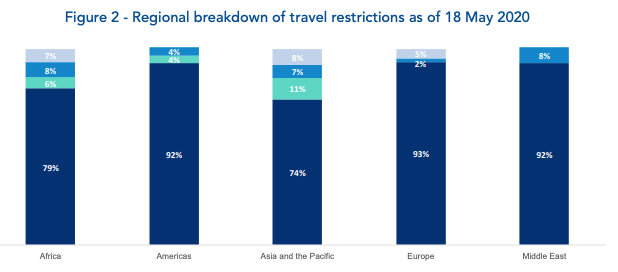
Travel restrictions in relation to the economic importance of tourism The following analysis focuses on the relations between travel restrictions and the importance of tourism for the economy of destinations. For this purpose, destinations were grouped in four clusters of economic importance, namely, low, moderate, considerable, and high (Table 1).
The analysis shows an inverse relationship between the economic importance of tourism for the economy of destinations and the variety of measures applied. In fact, the variety of measures applied by destinations decreases with increasing economic importance of tourism (Figure 3).
In destinations where tourism is of low economic importance, additional measures to the complete closure of borders were applied in 32% of cases, while for the rest of clusters, the application of additional measures to the complete closure of borders continuously decreases to reach 14% in the case of destinations where tourism is of high economic importance.
It can also be observed that with increasing importance of tourism for the economy, the complete closure of borders is the measure more frequently applied.

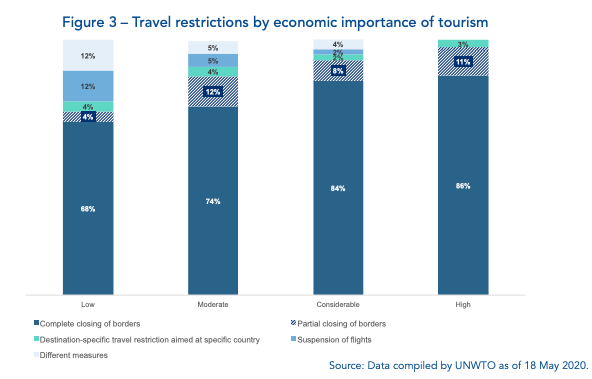
Travel restrictions in Small Island Developing States (SIDS)
As of 18 May 2020, 46 SIDS representing 85% of the total 54 SIDS destinations have completely closed their borders.
Looking at the regional breakdown of SIDS, all SIDS in the African region (6 destinations) and in the Middle East (1 destination) are completely closed. In the Americas, almost all SIDS (93%) have applied these same measures (26 destinations). In Asia and the Pacific only 68% of SIDS (13 destinations) have completely closed their borders, while the remaining SIDS in this region have opted for destination-specific travel restrictions banning the entry only for passengers coming from countries significantly affected by COVID-19 (Figure 4).
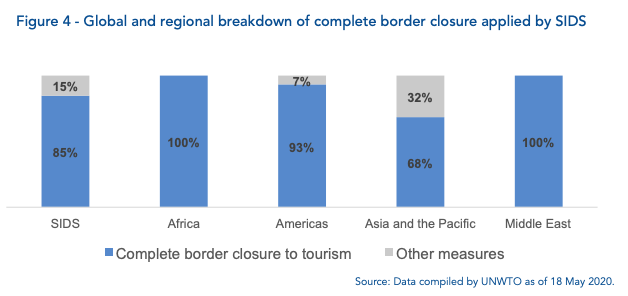
Many SIDS (41% of all SIDS) were among the first destinations that introduced travel restrictions due to the COVID-19 outbreak and so far, no SIDS has lifted the travel restrictions introduced.
On 7 February 2020, one week after COVID-19 was declared a Public Health Emergency of International Concern (PHEIC), out of the 51 destinations that already had implemented travel restrictions, 22 destinations were SIDS, mostly from Asia and the Pacific (27% of the total 51 destinations). At present (14 weeks later), these 22 SIDS still have travel restrictions in place, with 18 of them having their borders completely closed.
In line with the previously noted trend that the variety of measures reduces with increasing economic importance of tourism, the same trend can be observed for SIDS, which in their majority have a moderate to the high importance of tourism in their economies. Also notable, that complete border closures are more common among SIDS in comparison to global averages.
Travel restrictions in the Schengen Area
The external borders of the European Union (EU) have been closed to non-EU citizens for more than two months.
The internal borders in the Schengen area 14 are being managed in accordance with various restrictive measures that limit the movement of tourists between destinations of the region (intraregional tourism15). The complete closure of borders for international tourism is the most common type of measure, applied in 69% of destinations (18 destinations).
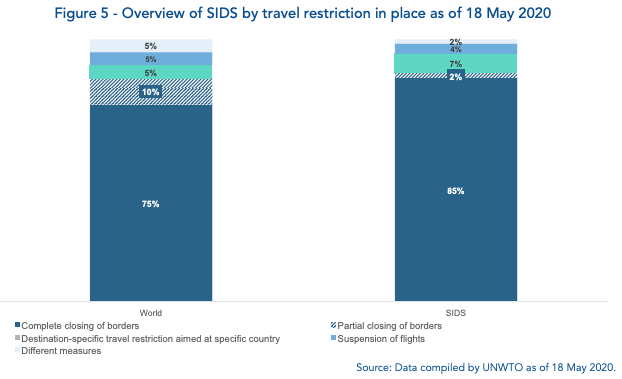
On 15 April 2020, the European Commission (EC) issued a Joint European Roadmap towards lifting COVID-19 containment measures16 which proposes a “phased approach for the opening of internal and external borders” . 17 For the lifting of internal borders, the Roadmap points at three main elements to be considered when assessing the readiness to gradually lift the travel restrictions and the controls at internal borders, namely i) epidemiological criteria, ii) health system capacity and iii) appropriate monitoring capacity. It also highlights that restrictions “should first be eased between areas with a comparably low reported circulation of the virus”. The reopening of external borders and access of non-EU residents to the EU should happen in a second stage and “should take into account the spread of the virus outside the EU”.
On 13 May 2020, the EC presented guidelines on the future of Tourism and Transport for 2020 and beyond19, in which a set of recommendations are provided, including the gradual lifting of internal travel restrictions with all necessary safety and precautionary measures in place.20 For this purpose, criteria have been elaborated that Member States shall take into account for the lifting of restrictions to free movement and internal border controls, highlighting that travel should first be lifted in areas “with a comparable epidemiological situation based on guidance issued by the European Centre for Disease Control (ECDC), and where sufficient capabilities are in place in terms of hospitals, testing, surveillance and contact tracing”
The guidelines also highlight the necessity to continuously update communications on this matter, as to ensure that “people crossing borders can plan and act on the basis of transparent information and full awareness of the situation”.22 In this context the creation of a single website for travellers is proposed. Another precondition listed is the ability to ensure that containment measures, such as physical distancing, can be followed throughout the traveller’s journey. The lifting shall take place in three phases: Phase 0 being the current situation where internal borders are closed; Phase 1 indicates that, if complete opening of national borders is not possible due to the epidemiological developments, connections could be established across regions of Member States with a sufficiently similar epidemiological situation; and Phase 2 which consists in lifting all COVID-19 related restrictions and controls of internal borders, while keeping the necessary health measures in place.
With the upcoming summer season in the Northern Hemisphere, the opening of borders for international tourists has become a much-debated topic among the Member States of the Schengen area. A number of destinations have already announced concrete days for opening borders for tourists.
Evolution of travel restrictions over time
With the spread of COVID-19 cases in an increasing number of countries, the number of travel restrictions has also grown (Figure 6). When on 30 January 2020 the World Health Organization declared COVID-19 a PHEIC, 11 destinations had already implemented travel restrictions directed at travellers coming from China and prohibiting their entry into the destination. One week later, on 7 February 2020, this number had grown to 51 destinations. By then, 24 destinations worldwide had reported confirmed cases of COVID-19.
On 11 March 2020, when WHO declared COVID-19 a pandemic, a total of 85 destinations had travel restrictions in place. After the declaration of the pandemic, a new wave of restrictions to entry was triggered, this time mainly in Europe. As a result, between 9 and 16 March 2020, an additional 38 destinations introduced travel restrictions, out of which 20 were from Europe, bringing the total to 119 destinations worldwide.
Two weeks after the declaration of the PHEIC, the number of destinations with restrictions more than doubled, from 85 to 181 destinations Between 24 March and 20 April 2020, all remaining destinations introduced travel restrictions bringing the total to 217 destinations which represent 100% of destinations worldwide, a situation never seen before.
t is now for more than five weeks that 100% of all destinations worldwide are having currently COVID-19 related travel restrictions in place.
Categories of travel restrictions affecting international tourists
At the beginning of the crisis, two main categories of travel restrictions were observed, one directed at passengers coming from a country that had confirmed COVID-19 cases (destination-specific travel restriction) and the other one being the restrictions of the visa.
Over time additional measures were observed, such as the request for medical certificates upon arrival at a destination or the request for self-isolation or quarantine.

Once WHO declared COVID-19 a pandemic, two new, more extreme categories of travel restrictions started to be applied, namely the complete and partial closure of borders and suspension of flights by governments.
These two categories are, at the current date, used by the majority of destinations worldwide (88%).
The following categories of COVID-19 related travel restrictions are being applied across destinations worldwide (total destinations = 217) (Figure 7):
Complete or partial closure of borders
As of 18 May 2020, 185 destinations (85%) have completely or partially closed borders (increase from 166 destinations on 27 April 2020).
Out of these, 163 destinations have completely closed their borders (increase from 156 destinations) for international tourists including air, sea, and land border. Some exemptions are usually made for nationals residents, commuters, diplomats, and essential travel purposes.
The remaining 22 destinations have partially closed borders, (increase from 10 destinations) resulting in a significant reduction of the entry points to access their destinations.
Suspension of flights:
11 destinations (5%) have suspended completely or partially international flights. This is a decrease from 26 destinations in the last report.
Destination-specific travel restriction:
10 destinations (5%) are implementing the closing of borders in a more differentiated manner by banning the entry for passengers from specific countries of origin. This is an increase from 9 destinations in last report.
Different measures:
The remaining 11 destinations (5%) are applying different measures, such as quarantine or self-isolation for 14 days, visa measures, or requesting a medical certificate upon arrival. This is a decrease from 16 destinations in the last report.
هتي ڪلڪ ڪريو for a list of measures recommended by country.
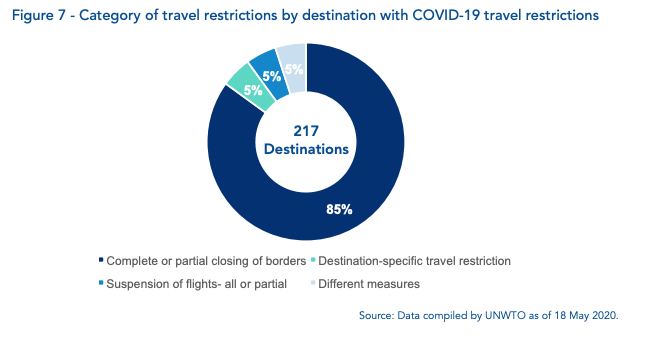
هن آرٽيڪل مان ڇا وٺو:
- o 74% of destinations in Africa o 86% of destinations in the Americas o 67% of destinations in Asia and the Pacific o 74% of destinations in Europe o 69% of destinations in the Middle East.
- The impact of travel restrictions on international tourism due to COVID-19 is reflected in the available data on international arrivals for the first quarter of 2020 which shows a decrease of 22%, while international arrivals in the month of March have been down by 57%.
- Travel restrictions including the complete or partial closure of borders, destination-specific travel restrictions, suspension of flights, and other measures have been in place for ten weeks in 37% of destinations worldwide (80 destinations) and during the past 14 weeks in 24% of destinations worldwide (51 destinations).























